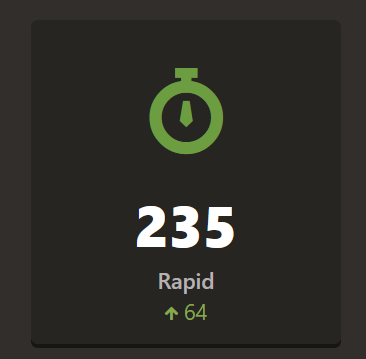In-Depth Post #4 2022
Hello and welcome back to my blog. This post will focus on my chess in-depth project.
Progress Report
Since my last post I have accomplished my goal of completing the “Opening Principles” unit on chess.com, and I have begun the “Winning the Game” unit, covering the lesson on the 4-move checkmate. Additionally, I have continued playing chess frequently on the rapid setting on chess.com, reaching my goal of getting a 230 rating. 
Chess terms
In my last post, I said I wanted to explore the chess terms section on chess.com in the upcoming weeks. I did some research on the terms blunder, bad bishop, and backward pawn. Here is what I learned about each term and how each one was able to improve my understanding of the game.
Blunder
After every game you play, chess.com gives you a full analysis of your game. In the analysis, there is always a section called a blunder. I never fully understood what it meant so I decided to do some research.

Definition: In chess, a blunder happens when a player makes a move that negatively affects their position in a significant way. As a result, it can often cause a player to lose material or be checkmated. A blunder gives the opponent a great advantage.
It is important to recognize blunders, as a single blunder can turn a game around. Avoiding these errors is an essential step to winning more games, and it is the main difference between beginners and more advanced players. Unfortunately, though, no one is blunder-proof. Even professional chess players make game-losing moves from time to time.
Now that I know what blunders are, I can better understand the game analysis chess.com provides, and improve from my mistakes.
Bad Bishop
Definition: A bad bishop is a bishop that is blocked by its own pawns, making the number of squares it controls very low. There is a relationship between the pawn structure and the strength of a bishop: if most of your pawns are on light squares, then the light-squared bishop can be restricted (the same is true for dark-squared bishops and pawns on dark squares). If you have just one bishop, you should try to place your pawns on the squares of the opposite colour of your bishop. If you do this, then you can control squares of both colours, and your bishop can move more freely.

Example: the black bishop on b7 is considered a bad bishop because it is blocked by its own pawns.
The ability to recognize bad bishops is very important. If you have this ability, then you can try to avoid having bad bishops in the first place. Additionally, it will help you be more aware of your opponent’s pieces and when you can take advantage of their bad pieces.
Since learning about bad bishops, I have been noticing them a lot more in my games and striving to avoid getting them. I have become more strategic in the placement of my pawns in accordance with my bishops.
Backward Pawn
Definintion: A backward pawn is a pawn that has no support from other pawns (because they have advanced ahead of the backward pawn or because they no longer exist). A backward pawn cannot advance freely without being captured and almost always supports another pawn on an adjacent file.
Backward pawns are important for strategical reasons, mainly because they are a weakness in pawn structure, which can be targeted and attacked. In general, you want to avoid creating backward pawns for no reason as you are creating a target for your opponent to attack! Similarly, it is important to know what backward pawns are so that in the event that your opponent creates one, you can plan to attack this pawn.
Reading this article gave me a slight introduction to pawn structures. Previously, I wouldn’t think too much about how my pawns were protecting one another, however that changed after reading this article. In the upcoming week, I plan on doing some more research on pawn structures
Goals
I will continue my lessons on chess.com and progress in the “Winning the Game” unit. Additionally, I want to do some research on specific chess openings and defenses like the Italian Game, Sicilian Defense, and French Defense. Lastly, on chess.com I want to read the article on pawn structures and examine a few of the popular ones.
I will continue to play chess on the rapid setting and I hope to bring my rating up to 335 by the next post.
Mentor Questions
1. What has been my most difficult mentoring challenge so far? Why?
Honestly, the most difficult challenge has been finding times when we could meet that worked for both of us. My mentor is quite busy so setting up meetings took some effort.
2. What is working well? Why?
In my previous post, I mentioned that I wanted to write a list of questions prior to meeting with my mentor to help guide our meetings more. For our past two meetings, I created a list of questions. These lists not only helped guide our meetings but they also allowed me to remember very specific questions that came up while I was playing chess online. The questions I began asking were a lot more insightful and specific. I think I will continue creating these lists as they only improved the quality of our meetings.
3. What could be working better? How can you make sure this happens?
Truthfully, our meetings have been going really well. Our discussions are really meaningful, and I retrieve a lot of good information from them. The games we play are fun, and I also learn a lot from them. My experience only grows when I play with my mentor. Currently, there isn’t anything that I believe could be improved.
Thanks for reading my in-depth post, see you in the next one.